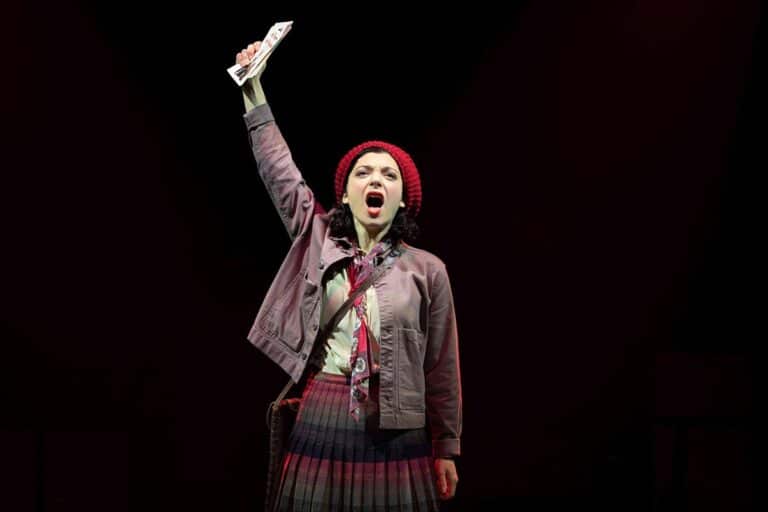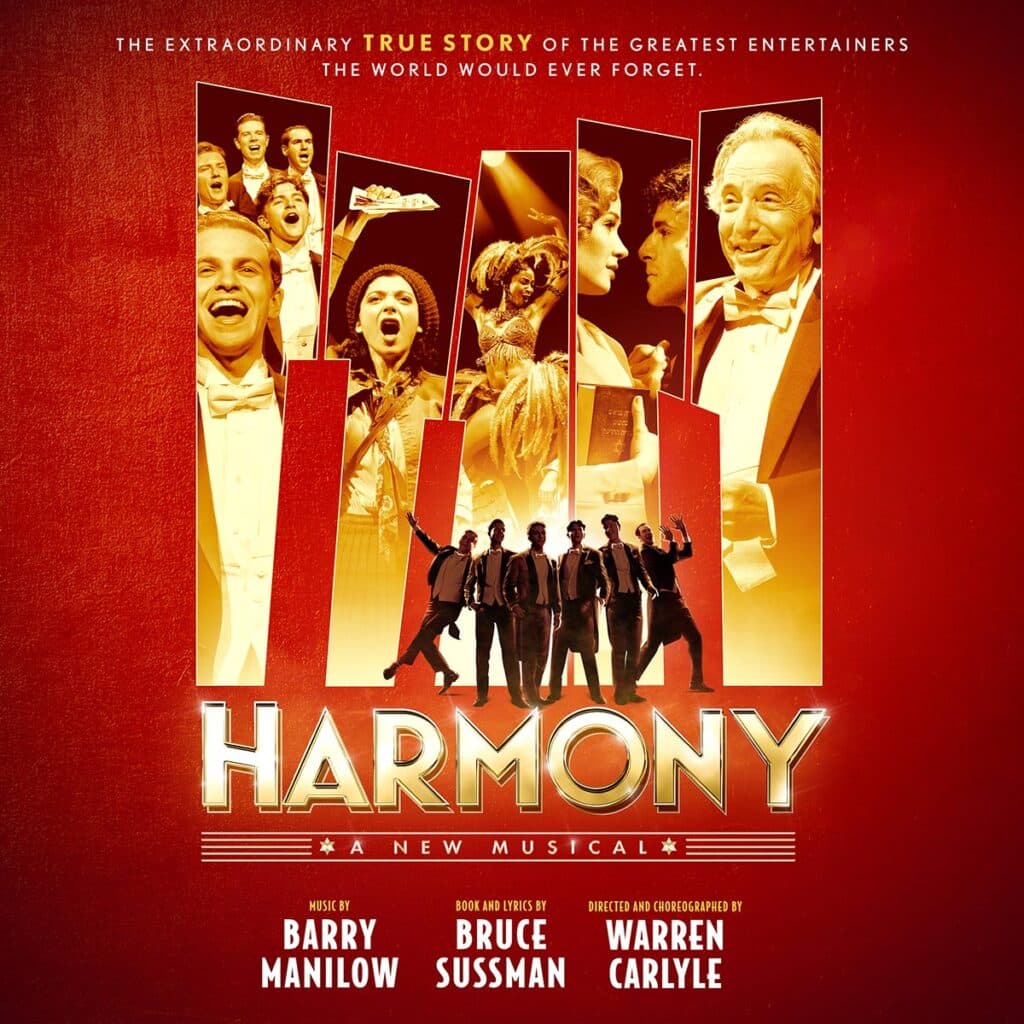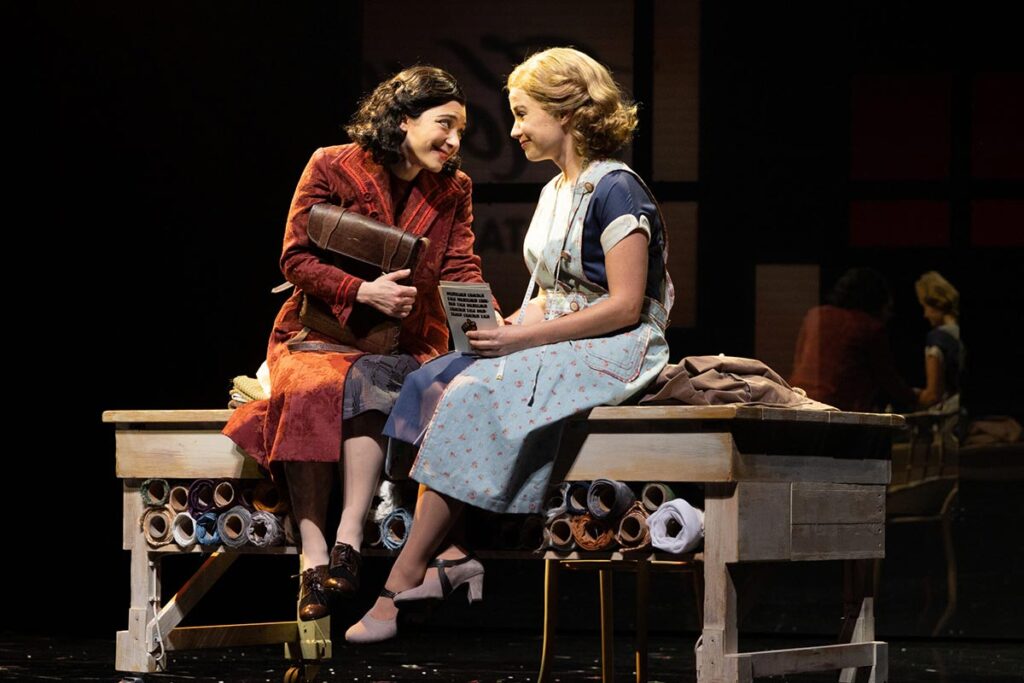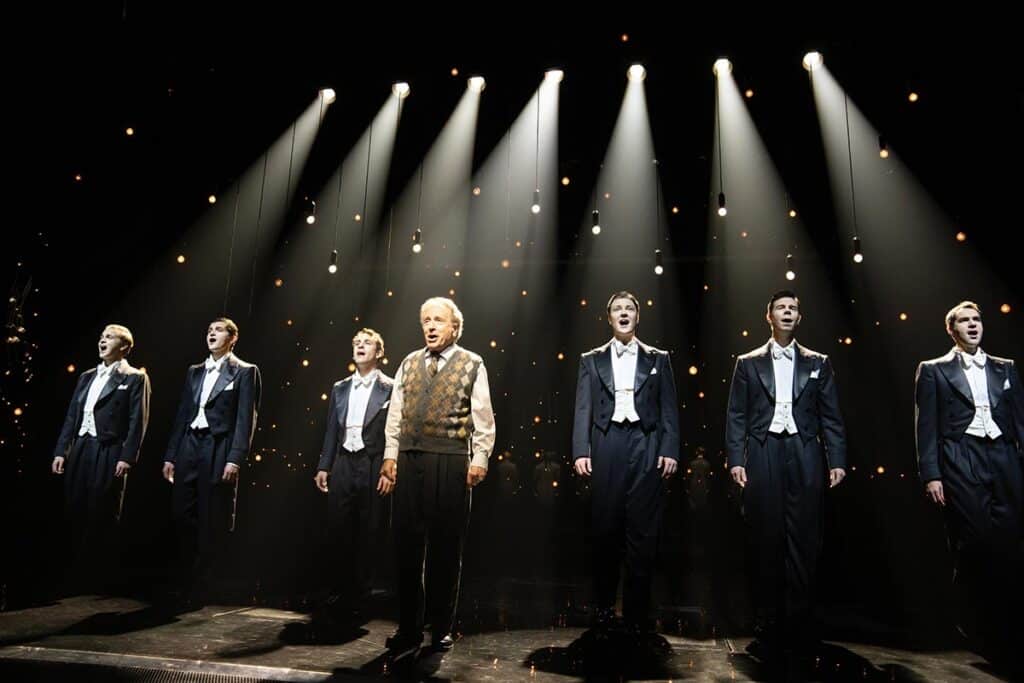
Julie Benko has spent her Broadway career bringing multifaceted Jewish characters to life.
The 34-year-old portrayed Fanny Brice in the rave-reviewed run of “Funny Girl” and previously was an understudy for both Chava and Hodel on the recent Broadway production of “Fiddler on the Roof.”
Read more: 10 Jewish characters from Broadway musicals you should know
Since October, Benko has taken on a new Jewish character, originating the role of Ruth Stern in Barry Manilow and Bruce Sussman’s “Harmony.”
Unpacked caught up with Benko before the show’s closure on Feb. 4 to discuss the significance of “Harmony” and why she feels we need more Jewish representation on stage.
“Harmony” attempts to right history’s erasure of the Comedian Harmonists
If you’re not familiar with the story of “Harmony,” you’re not alone — the Comedian Harmonists are one of the most accomplished yet relatively unknown groups in the world’s music history.

One of the most famous singing groups in Europe during the 1920s and ’30s, the tight harmony group was largely erased from history solely because it consisted of three Jewish and three non-Jewish members.
The Nazi regime banned the group from performing, and Germans from listening to their records, due to their political satire and three Jewish members.
Now, the group’s history is being brought to light in Manilow and Sussman’s musical. The production’s creators fought for 30 years to get a Broadway run for their passion project. It has been well-received by audiences, praised as a moving production that skillfully blends the lighthearted with the serious.
Ruth represents the many Jewish women who fought against the Nazis

Ruth’s character in “Harmony” is a composite representation of Jewish women who were communist leaders during that time.
The outspoken young woman boldly expresses her political opinions while donning a bright red coat that reflects her communist beliefs, and is a speaker at many of Berlin’s rallies.
Benko shines in “This is Our Time,” a song of vignettes involving various characters. Ruth passionately addresses a group of fellow ralliers about economic inequality and the need to reshape Germany’s economic systems, encouraging them to “rise up.”
She openly displays her disrespect for the Nazi officers who attend the Comedian Harmonists’ shows and strongly disapproves of the group’s continued relationship with the German government.
Her character is the only Holocaust victim in the show, as Ruth is taken away by the Nazi regime for protesting against their policies. Benko worked with the writers to adjust lines that she felt better represented Ruth’s fiery personality.
In one of Benko’s shining moments in the show, she and co-star Sierra Boggess sing “Where You Go,” a moving ballad that draws from Biblical verses in the Book of Ruth.
However, instead of expressing her devotion to her mother-in-law, Benko sings about her dedication to her husband, affirming that she would not leave Germany despite her husband’s pleas for her to do so.
Like many other Jewish members of the resistance, Ruth stays in Germany, vowing to fight Hitler and fascism until her end.
Benko was able to shape Ruth’s character from the start
The 2022 New York Times breakout star for theater had never originated a role before Ruth. Benko appreciated working with Manilow and Sussman to develop the character, editing the script and mannerisms to match her vision.
“The role starts to contain a little bit more of your DNA in the scripts, which will be there forever, so you get to make this sort of indelible mark on the character because you’re in collaboration with the writers,” Benko said about crafting the character.
Although Harmonist Erwin Bootz, Ruth’s husband in the show, did marry a Jewish woman in real life, Ruth’s character does not reflect those experiences.
Unlike the real-life Ursula Bootz, who was non-political and eventually fled to the United States, remarried, and became a designer, Ruth in the musical is portrayed as a Bolshevik leader.
To prepare for the role, Benko interviewed Ursula’s daughter and found inspiration in female German and Polish Communist Party activists. She also researched the rates of Jewish intermarriage in pre-war Germany, which she was shocked to learn were similar to those in 2024.
“I found some very disturbing political cartoons that depicted interfaith couples. Jewish women were portrayed as disgusting, monstrous monkey-like figures, prompting questions about how a non-Jewish man could ever be attracted to this creature … Even though the Jews were quite secular and thought of themselves as German first, many of the Germans didn’t see them that way,” Benko said.
In “Harmony,” Benko portrayed a more serious side of the Jewish experience
Prior to starting rehearsals for “Harmony,” Benko alternated the role of Fanny Brice in “Funny Girl,” along with Lea Michele. Before that, she was Beanie Feldstein’s understudy for the character.
Portraying Fanny Brice, known for her comedic talent and Yiddish accent, was an opportunity for Benko to showcase her comedic skills.
In contrast, the role of Ruth allowed her to delve into the more distressing elements of Jewish history, exploring political activism Jewish women have led and the trauma of antisemitism and the Holocaust.
“A rabbi who I know says there’s the ‘joy’ and the ‘oy’ of being Jewish. ‘Funny Girl’ was the joy and ‘Harmony’ is the oy,” Benko said.
Especially since Ruth and Fanny were contemporaries — Fanny Brice is even mentioned in “Harmony” as a popular act of that era — Benko enjoyed wearing 1920s and ’30s attire and hairstyles to portray two women from entirely different backgrounds and walks of life.
Despite their differences, both Fanny and Ruth are empowered Jewish women living in the early 20th century.
“It’s been really interesting to show that Jewish women are not a monolith. By the circumstances of their birth and the place in which they were born, these two Jewish women had completely different lives,” Benko said. “I really like that I get to bring life to two very different women in the same time period.”
Benko hopes audiences are inspired by Ruth’s character
In seeing “Harmony,” Benko hopes that people feel inspired by the lesser-known stories of Jewish women who fought in the resistance against the Nazis.
The number of female political leaders in the 1920s and ’30s was small, and their histories are not as well-documented as their male counterparts. Benko hopes her character Ruth inspires audiences to learn more about these forgotten women who resisted the Nazis.
“My character is a woman leading the revolution, and that’s not something that we think of, necessarily, even now,” Benko said.
In portraying Ruth, Benko has allowed many Jewish women to see themselves reflected on stage, and Jewish women in particular have found her performances to be emotional and touching.
“I get a lot of Jewish women in tears at the stage door thanking me for representing them on stage. It resonates with me to know that I’m representing so many people on stage who feel like they don’t have that representation anywhere else on Broadway,” Benko said. “Everybody wants to feel like they are seen and that their stories matter.”
The relevance of “Harmony” amid the spike in antisemitism today

Benko said she found catharsis in being involved in a production centered on antisemitism amid the global spike in antisemitic incidents and sentiments. “Harmony” opened less than two weeks after Oct. 7.
She is proud that “Harmony” educates its viewers on the signs of antisemitism and fascism and the efforts of Jews and non-Jews to fight it.
“There’s been such a huge surge in antisemitism worldwide that we all feel. With the show mirroring what’s going on in 2024, it’s been helpful to have this show to pour my feelings into,” Benko said.
Benko emphasized how important it is to highlight the untold stories of Jews during World War II and to continue sharing those stories.
During rehearsals, the actors discussed and questioned why the characters chose to remain in Germany knowing the growing antisemitism.
“I think this story really examines the question of, ‘How did people not see how bad it was getting?’ I think those are questions that often get glossed over when people are looking at the horror of the Holocaust.
“I think that that is a part of the show that really resonates now, and is a reason why it’s really important to tell stories like ‘Harmony.’ You examine the warning signs of the rise of fascism, and that’s exactly what’s happening today all over the world,” Benko said.
The importance of Jewish representation in theater
While the Jewish characters in “Harmony” are all played by Jewish actors, Benko does not believe that every Jewish role must be portrayed by a Jewish actor.
Instead, she thinks it’s only a necessity if their Judaism is central to the character’s identity. Fanny Brice, for example, dresses as a clown covered in bagels speaking in a funny Yiddish accent, so Benko thinks the role should be reserved for Jewish actors.
Benko’s concern lies in cases where non-Jewish actors don’t make an effort to understand the culture or conduct their own research when portraying Jewish characters on stage.
Read more: Should non-Jewish actors play Jewish roles in Hollywood?
Benko is frequently asked by community theaters whether they should produce “Fiddler on the Roof” with a limited number of Jewish actors and whether non-Jews should be allowed to audition.
She believes that in community theater settings, where the primary goal is to provide recreational theater experiences to the local community and no one is receiving payment for their performances, the casting rules should be more flexible.
“I would rather have Jewish stories be told and ‘Fiddler on the Roof’ get performed. Maybe the actors don’t know any Jewish people and they learn a little bit about the history, culture and traditions. And I think that’s really beautiful,” she said.
Originally Published Jan 26, 2024 03:36PM EST
